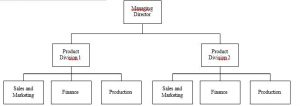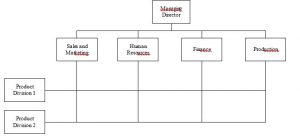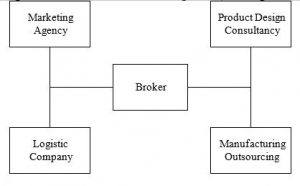NATURE OF ORGANISING
The organisation of a firm is closely linked to the planning process; it creates the structure in which the firm fits its strategy. The organisational structure is one of the tools that management uses to get work done.
Core Features of Organising
Organisational Structure
Organisational structure refers to the framework in which the organisation sets out how tasks are divided, resources are deployed and departments are coordinated. The main features of organisational structure are:
- The set of tasks assigned to individuals and departments.
- The formal reporting relationship, including lines of authority, decision responsibility, number of levels and the span of a manager control.
- The systems that ensure effective coordination across departments.
The characteristics of the vertical structure of an organisation are represented in the organisational chart.
Work specialisation
Work specialisation, which is also called division of labour, is the degree to which organisational tasks are subdivided into separate jobs. This is done because in many work situations it is more efficient if employees are allowed to specialise on a particular task.
Chain of Command
The chain of command is the unbroken line of authority that links all persons in an organisation – it effectively shows who reports to whom. A closely linked principal is called Unity of Command, which means that each employee is held accountable to only one supervisor.
Authority, Responsibility, Accountability and Delegation
Authority is defined as the right to make decisions and take action.
Responsibility is the obligation of a person to complete a given task.
Accountability is the requirement that managers and workers accept the consequences of their actions and report those actions to their immediate supervisor.
Delegation is the process that merges authority, responsibility and accountability. Senior management may delegate authority and responsibility to lower level management but they are still accountable for the outcome.
Span of Control
Span of control defines the number of subordinates a manager supervises. Wider spans of control give employees greater freedom while a narrow span of control involves close supervision of subordinates. The breath of the span of control is a function of the complexity of the organisational structure and task complexity coupled with the amount of time required.
The exact number will depend on a variety of factors such as:
- The geographic proximity of the personnel: The more concentrated the work area is the greater span of control that is possible.
- The functional similarity of operations: A manager can exercise a broad span of control if the majority of staff performs similar tasks.
- Functional complexity of the organisation: Organisations with complex functions require narrow spans of control.
- The need of the employees for supervision: The greater the need for supervision the narrower the span of control.
- The clarity and complexity of plans: Well defined and straight forward plans support a broad span of control.
- The level of managerial support available: The span of control can be extended if there is support from higher-level managers.
- The need for coordination within functions: A narrow span of control will be necessary in organisations where there is a need to coordinate between functions.
Centralisation versus Decentralisation
The extent to which authority is delegated depends on the extent of centralisation or decentralisation. A decentralised organisation is one in which the authority to make decisions and to commit money and materials is widely delegated throughout every level of the organisation. A centralised organisation is one where little authority is exercised outside the key group of senior managers.
ADVANTAGES OF DECENTRALISATION
The advantages of decentralisation are as follows:
- Top management are free to concentrate on their strategic responsibilities.
- It speeds up operational decisions as they can be made nearer to where they apply.
- It allows local management to be flexible.
- It can contribute to staff motivation.
- It encourages responsibility among junior managers.
DISADVANTAGES OF DECENTRALISATION
The main disadvantages of decentralisation are,
- Control and co-ordination by management (top management in particular) is more difficult to accomplish.
- Communication is more difficult but also more important.
- It can encourage people to focus on their own individual goals rather than the organisation’s goals.
- It requires well-trained, capable and motivated managers.
Overall, the advantages of decentralisation outweigh the disadvantages because of the pressure on modern organisations to be flexible and respond quickly to the business environment.
Tall versus Flat Organisational Structures
| Flat organisations | Tall organisations |
| Decentralised authority | Centralised authority |
| Few levels of management | Many levels of management |
| Wide span of control | Narrow spans of control |
Table 4.1: Tall versus Flat Organisational Structures
A flat structure would generally apply to smaller organisations of 500 employees or less; however control can become unmanageable for some managers and supervisors. In flat organisations managers are more likely to delegate responsibilities.
The advantage of tall organisations is they can maintain a very high degree of specialisation of functions and roles. However, tall organisations tend to be very formalised with standardisation of procedures that usually discourages initiative and risk taking.
APPROACHES TO STRUCTURING ORGANISATIONS
Functional Approach
In this type of organisational structure tasks are linked based on common function (Figure 4.1). For example, all tasks associated with production are grouped in a single function and all sales activities are grouped together. Figure 4.1 is an organisational chart of a functional organisation.
Figure 4.1: A functional organisational structure (Plunkett, W. 2007)

There is a high degree of division of labour and specialisation in this approach, which can yield economies of scale. However the high degree of coordination required between departments may result in delays in adapting to changes in the external environment.
Divisional Approach
In this approach, departments are grouped together into separate self-contained divisions based on a common product or a geographical region (Figure 4.2). The divisional approach has the advantage that reporting lines and chain of command are in line with the main activities of the organisation. This provides a clear framework for channelling strategic efforts to achieve the strategic aims of the organisation.

The main disadvantage of this type of organisation is that divisions can become compartmentalised and focused on divisional interest to the detriment of the overall organisation. Divisions may also become isolated and unaware of what the other sections of the business are doing.
Matrix Approach
In the matrix approach, both functional and divisional chains of command are implemented simultaneously and overlap with one another in the same departments. Two chains of command exist and employees report to two bosses.

This approach tries to bring the best of both worlds – functional specialisation and expertise with a product focus. The main disadvantage is that individuals may experience divided loyalties between individual bosses.
FACTORS AFFECTING ORGANISATION STRUCTURE (LYNCH AND ROCHE, 1999)
In general, the structure of an organisation depends on a variety of contingency factors. Different organisations require different types of structure. The factors involved in the choice of structure include:
- Strategy
- The Business Environment
- Size and Life Cycle
- Manufacturing and Service Technologies
- Department Interdependences
Strategy
In general, an organisation’s structure follows the strategy being pursued. For example, a start-up company operating in a domestic market may be able to centralise decision making to a greater extent than an export led company. A company pursuing a differentiation strategy might require a more flexible structure than a company pursuing a low cost strategy.
The Business Environment
Firms operating in a dynamic environment need a more flexible structure. Firms operating in a stable environment need a rigid structure, whereas firms operating in an intermediate environment need a hybrid structure.
Size and Life Cycle
One of the major determinants of organisational structure is the size of the organisation. Larger firms that have greater access to capital can attract better management, greater market share and superior market information than smaller firms. As an organisation grows in size, so too must its structure, as more levels or layers of management are needed to co-ordinate operations. The problems for large firms are how to manage layers of managers, how to delegate to all their employees, and how to obtain commitment and employee satisfaction, while at the same time achieving the organisation’s objectives.
Manufacturing and Service Technologies
There is a direct relationship between the level of technology involved and the required structure of the organisation. In general the use of IT within organisations is reducing management layers and increasing spans of control. Also, very high levels of customer service requirements suggest the need for locally responsive decentralised types of structure. Furthermore, a company utilising high levels of mass production to produce standard products might employ a formal structure as workers are required to carry out repetitive tasks.
Department Interdependences
This refers to the level of dependence between departments’ vis-à-vis resources and supplies in accomplishing tasks and has an influence on the required organisational structure. Where interdependence is low, there is little need for a structure, which facilitates interaction, information sharing and coordination.
RECENT DEVELOPMENTS IN ORGANISATIONAL STRUCTURE
The challenge facing organisations is the need to become more flexible and responsive to changes in the external environment. There has been a shift from bureaucratic hierarchical forms of organisation to flatter, more adaptable ones. The changes in organisational practices can be grouped under the following headings:
- Flatter hierarchies: Many organisations are de-layering their management structure in an effort to speed up decision-making and communications. The widespread use of information technology has facilitated a reduction in layers of clerical management in particular. Overall, in many companies the number of managers and in particular middle management is being reduced.
- Emphasis on teamwork: The use of different teams from project teams to product development teams and sales teams has become a common feature in many organisations, particularly in the technology sector. The use of the team approach is an effort to improve employee commitment and motivation, thereby increasing productivity and profitability. The subject of teamwork is covered in more detail in Chapter 5.
- More distributed responsibility and decision-making authority: Flatter organisations have facilitated a move to delegate authority down to lower levels in the organisation than was previously possible. The emergence of teamwork has enabled decision making to be moved closer to the front line.
NEW APPROACHES TO DESIGNING AND STRUCTURING ORGANISATIONS
Organisational thinking has continued to evolve in the last 100 years and with it the structure of organisation continues to change. Two of the new organisational structures that have developed are:
- The Network Organisation
- The High Performance Organisation
The Network Organisation
The network organisation extends the trend of decentralisation further by granting more authority to departments and functions. Instead of the traditional hierarchical model of authority within the organisation, control and responsibility is assigned to effectively independent units. The aim of this structure is to enable different parts of the organisation to work together. The networking approach can be taken a step further where the network involves external suppliers and customers. Alliances with competitors can be formed where the relationship can be mutually beneficial. In the airline industry airlines that are in competition on some routes often form alliances that allow passengers to switch between airlines on different segments of long haul routes. Another form of the network approach is where an organisation can outsource a part of its operation from other companies. The main company becomes a small central broker electronically connected to other companies that perform vital functions. Department are independent, contracting services to the broker for a profit (See Figure 4.4).

A similar approach to networking is called the modular approach; an example of this approach is where a manufacturing company uses outside suppliers to provide entire chunks of a product, which are then assembled by a handful of workers.
Another example is when Apple developed its iPod digital music player; it outsourced the audio chip design and manufactures a company in the US and the final assembly to a Taiwanese company. Doing this not only reduced cost and sped up production but also allowed Apple to concentrate on what it does best – design innovative products with easy to use software.
Advantages of the network approach include:
- Can draw on expertise worldwide
- Highly flexible and responsive
- Reduced overhead costs
Disadvantages of the network approach include:
- Loss of control when key business activities are outsourced
- Loss of competitive advantage when core business activities are mistakenly outsourced
- Greater demand on managers
- Employee loyalty is weakened
The High Performance Organisation
High performance organisations are structured to encourage and enable employees to deliver a high performance. Key aspects of this approach are the development of self- managed teams, decentralisation and a focus on products, services and customers. Employees are encouraged to take responsibility and also deal directly with customers and suppliers. These types of structures tend to be common in the technology sector where innovation and flexibility are needed to be able to deal with a rapidly changing environment.
THE MINTZBERG FRAMEWORK – FIVE TYPES OF STRUCTURE
According to Mintzberg (1979), the choice of an appropriate structure depends on the productive combination of an organisation’s strategy (given its size and market position), and its internal culture (what type of decision making and co-ordination does it employ, and how does its division of labour function). Mintzberg lists five types of organisation:
- Simple Structure: This suits small organisations in a competitive environment, such as family-owned shops. Direct supervision of employees is possible in these organisations, and is necessary as they are required to react quickly to changes in the environment.
- Machine Bureaucracy: This is found in many large organisations that operate in a stable environment such as the civil service or large production organisations. Its main features are standardisation of work processes and centralised decision-making.
- Professional Bureaucracy: This is appropriate for organisations such as hospitals, which operate in a stable but complex environment. Decision-making is relatively decentralised, and co-ordination of activities is reliant on the standardisation of employee skills.
- Divisionalised Structure: These operate in organisations where decision-making is split between headquarters and various divisions operating in distinct markets. Machine bureaucracies can develop in each of the divisions, so that the output of each is standardised to the satisfaction of headquarters.
- Adhocracy: This is usually found in young organisations producing technical products, where organisational flexibility and dynamism is key. Decision-making is spread throughout the organisation and specialist project teams are set up as required.
